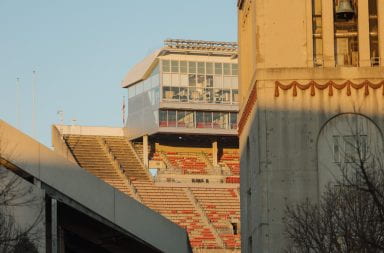
To honor those who have lost their homes, families and lives to the deadly storms currently wreaking havoc across the globe, over 30 students and their organizations held a vigil on The Oval Thursday evening. Credit: Ris Twigg | Assistant Photo Editor
As images of flooded streets, torn-down homes and distressed families fill Ohio State students’ televisions and news feeds, some took to The Oval Thursday to honor those affected by the storms, also hoping to send one message: climate change matters.
Representatives from Keep Wayne Wild, Renew OSU, the Climate Reality Project, the Coalition of Immokalee Workers and several other organizations spoke to the crowd gathered around the Thompson Statue to share their condolences for those affected by the hurricanes and extreme flooding, while calling on the students to take action against climate change.
“Currently, even though the rhetoric is around hurricanes, we know that climate change extends past hurricanes,” said Maria Fredericks, a third-year in environmental policy and decision-making, and president of student organization Renew OSU. “[Climate change] has a big impact on droughts, on farmers, on communities across the world. So not just what we’re seeing in the media.”
After Hurricane Harvey hit Texas, Hurricane Irma swept through Puerto Rico before landing in Florida. On Wednesday, Hurricane Maria barreled down on Puerto Rico as a Category 4 hurricane. Hurricane Center forecaster Eric Blake called it the “most destructive hurricane in Puerto Rico history.”
Meanwhile in South Asia, Nepal, Bangladesh, India and Pakistan have been experiencing violent floods since August caused by an intensified monsoon season. Flooding has killed more than 1,200 people and displaced over 40 million more, leaving an already vulnerable population even more susceptible to risk, according to the Centers for Disease Control and Prevention’s website.
According to the National Oceanic and Atmospheric Administration (NOAA), human-induced warming of the planet will “likely cause tropical cyclones globally to be more intense on average — by 2 to 11 percent — [and] would imply an even larger percentage increase in the destructive potential per storm.”
For one student at the vigil, Hurricane Maria has hit too close to home.
Ansley Watkins, a first-year in exploration, met her friend Rocío while conducting research on the Mississippi River in Iowa two summers ago.
Rocío was born and raised in Puerto Rico and traveled to the U.S. to do research, said Watkins.
“I haven’t been able to contact her through the past two hurricanes,” Watkins said as tears welled up in her eyes. “I know she’s pretty resilient, but we do tend to keep up with each other a lot. She’s always worried about me even when nothing major is happening, so the fact that I can’t talk to her … I would just like to know [if she’s OK].”
Although her hometown in Georgia wasn’t touched by any of the storms, Watkins wanted to offer support for everyone affected — including her friend Rocío — and decided to attend the vigil after hearing about the event through her student organization, The Sierra Club Student Coalition.
Watkins stressed the importance of recognizing that climate change affects everybody
“It’s not just this generation, it’s all the generations after us,” she said.“If people don’t want to admit it directly, it does harm someone, somewhere in someway, and I think it’s really important that we try to minimize that harm.”


